Criminology Assignment: Crime and Government Drug Strategies
VerifiedAdded on 2023/04/22
|16
|3938
|490
Essay
AI Summary
This criminology assignment is divided into two parts. Part 1 defines crime, distinguishing it from civil wrongs, and categorizes various types of crime including crimes against persons, property, hate crimes, and white-collar crimes. It also discusses the criminal justice system's procedures and their relation to race, gender, and status. Part 2 examines the government's current approach to the drug problem, focusing on the Drug Strategy 2017. This includes aims to decrease drug use and improve recovery rates, with strategies involving demand reduction, supply prohibition, and recovery creation. The assignment also discusses the consequences of these approaches and explores alternative models such as decriminalization and regulated access. The assignment concludes with the importance of local government and community policing for crime prevention.
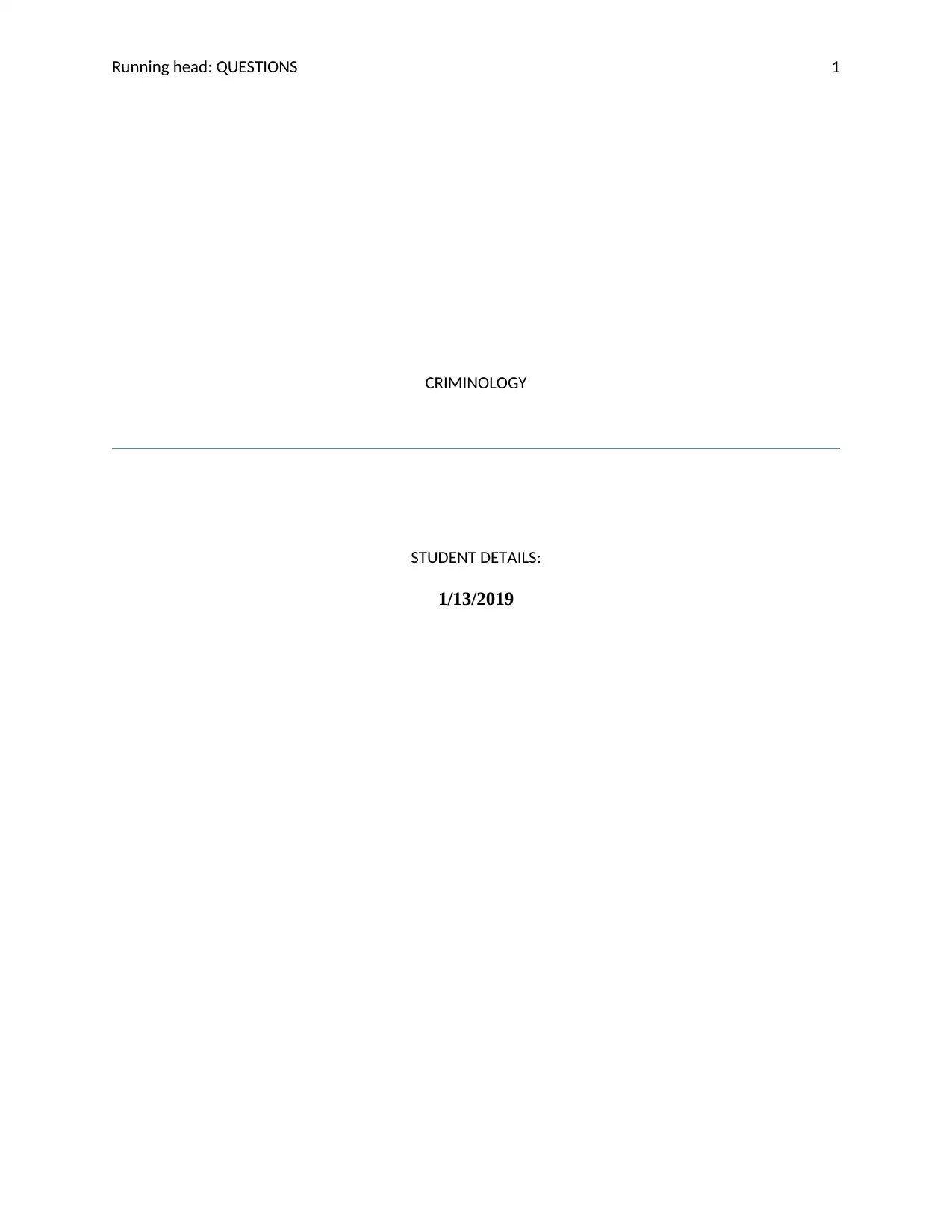
Running head: QUESTIONS 1
CRIMINOLOGY
STUDENT DETAILS:
1/13/2019
CRIMINOLOGY
STUDENT DETAILS:
1/13/2019
Paraphrase This Document
Need a fresh take? Get an instant paraphrase of this document with our AI Paraphraser
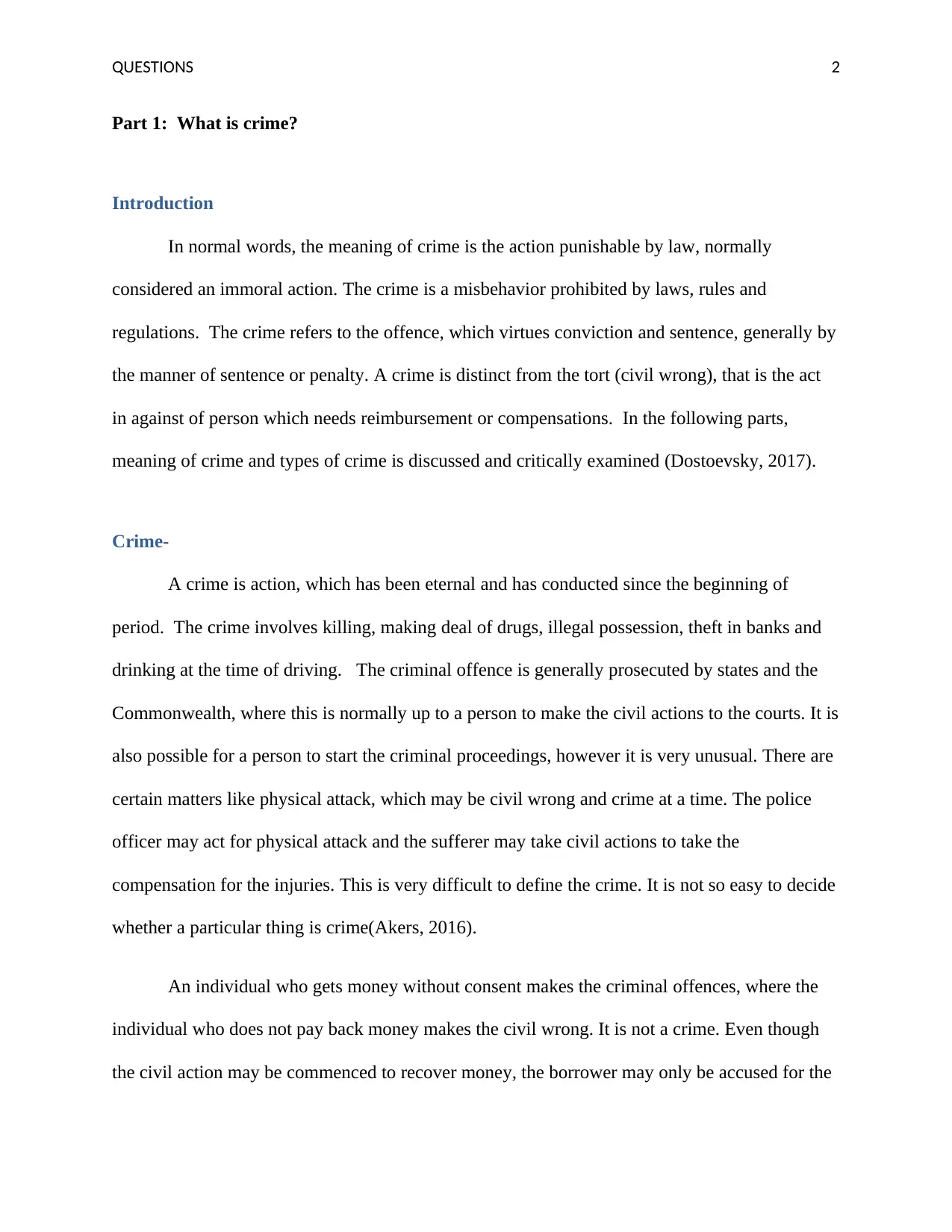
QUESTIONS 2
Part 1: What is crime?
Introduction
In normal words, the meaning of crime is the action punishable by law, normally
considered an immoral action. The crime is a misbehavior prohibited by laws, rules and
regulations. The crime refers to the offence, which virtues conviction and sentence, generally by
the manner of sentence or penalty. A crime is distinct from the tort (civil wrong), that is the act
in against of person which needs reimbursement or compensations. In the following parts,
meaning of crime and types of crime is discussed and critically examined (Dostoevsky, 2017).
Crime-
A crime is action, which has been eternal and has conducted since the beginning of
period. The crime involves killing, making deal of drugs, illegal possession, theft in banks and
drinking at the time of driving. The criminal offence is generally prosecuted by states and the
Commonwealth, where this is normally up to a person to make the civil actions to the courts. It is
also possible for a person to start the criminal proceedings, however it is very unusual. There are
certain matters like physical attack, which may be civil wrong and crime at a time. The police
officer may act for physical attack and the sufferer may take civil actions to take the
compensation for the injuries. This is very difficult to define the crime. It is not so easy to decide
whether a particular thing is crime(Akers, 2016).
An individual who gets money without consent makes the criminal offences, where the
individual who does not pay back money makes the civil wrong. It is not a crime. Even though
the civil action may be commenced to recover money, the borrower may only be accused for the
Part 1: What is crime?
Introduction
In normal words, the meaning of crime is the action punishable by law, normally
considered an immoral action. The crime is a misbehavior prohibited by laws, rules and
regulations. The crime refers to the offence, which virtues conviction and sentence, generally by
the manner of sentence or penalty. A crime is distinct from the tort (civil wrong), that is the act
in against of person which needs reimbursement or compensations. In the following parts,
meaning of crime and types of crime is discussed and critically examined (Dostoevsky, 2017).
Crime-
A crime is action, which has been eternal and has conducted since the beginning of
period. The crime involves killing, making deal of drugs, illegal possession, theft in banks and
drinking at the time of driving. The criminal offence is generally prosecuted by states and the
Commonwealth, where this is normally up to a person to make the civil actions to the courts. It is
also possible for a person to start the criminal proceedings, however it is very unusual. There are
certain matters like physical attack, which may be civil wrong and crime at a time. The police
officer may act for physical attack and the sufferer may take civil actions to take the
compensation for the injuries. This is very difficult to define the crime. It is not so easy to decide
whether a particular thing is crime(Akers, 2016).
An individual who gets money without consent makes the criminal offences, where the
individual who does not pay back money makes the civil wrong. It is not a crime. Even though
the civil action may be commenced to recover money, the borrower may only be accused for the
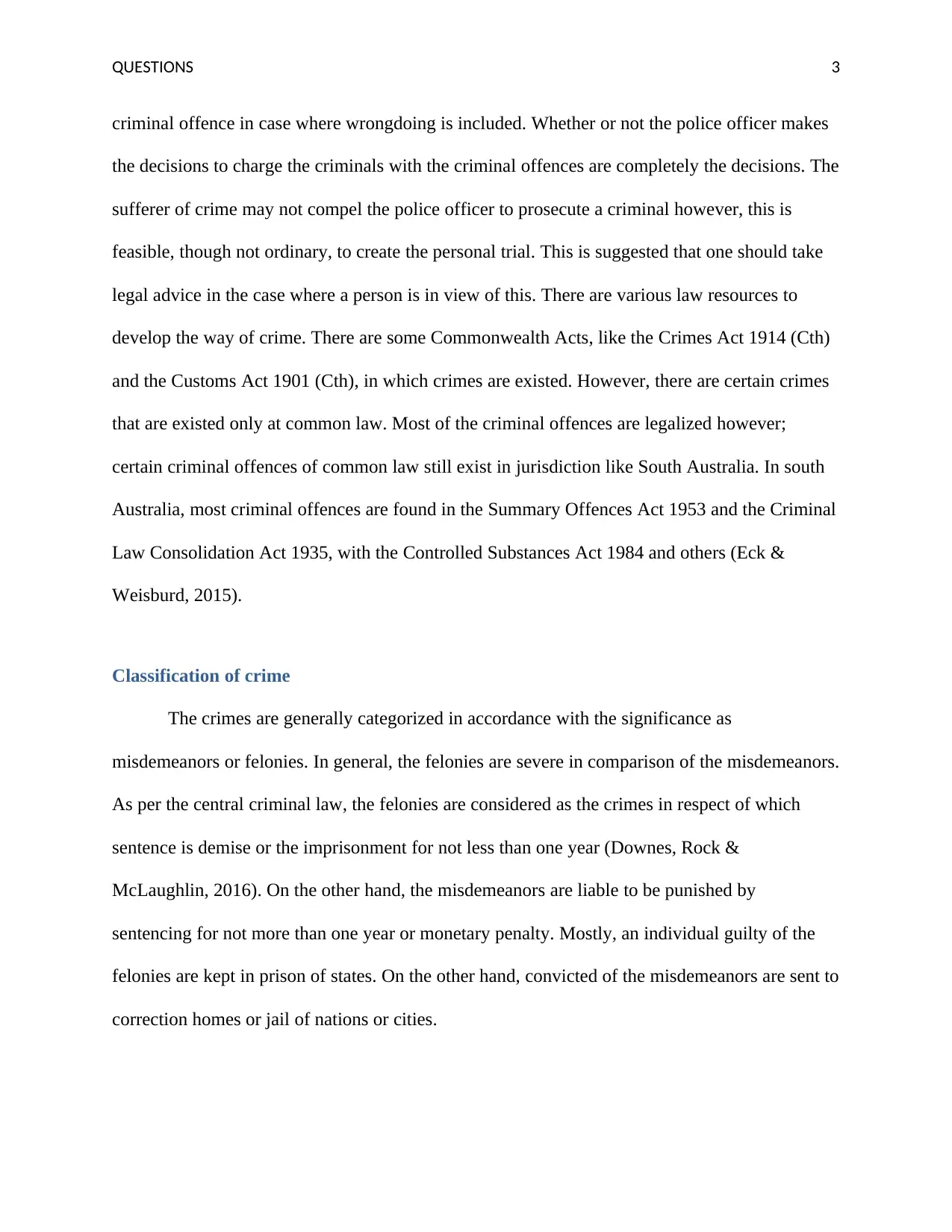
QUESTIONS 3
criminal offence in case where wrongdoing is included. Whether or not the police officer makes
the decisions to charge the criminals with the criminal offences are completely the decisions. The
sufferer of crime may not compel the police officer to prosecute a criminal however, this is
feasible, though not ordinary, to create the personal trial. This is suggested that one should take
legal advice in the case where a person is in view of this. There are various law resources to
develop the way of crime. There are some Commonwealth Acts, like the Crimes Act 1914 (Cth)
and the Customs Act 1901 (Cth), in which crimes are existed. However, there are certain crimes
that are existed only at common law. Most of the criminal offences are legalized however;
certain criminal offences of common law still exist in jurisdiction like South Australia. In south
Australia, most criminal offences are found in the Summary Offences Act 1953 and the Criminal
Law Consolidation Act 1935, with the Controlled Substances Act 1984 and others (Eck &
Weisburd, 2015).
Classification of crime
The crimes are generally categorized in accordance with the significance as
misdemeanors or felonies. In general, the felonies are severe in comparison of the misdemeanors.
As per the central criminal law, the felonies are considered as the crimes in respect of which
sentence is demise or the imprisonment for not less than one year (Downes, Rock &
McLaughlin, 2016). On the other hand, the misdemeanors are liable to be punished by
sentencing for not more than one year or monetary penalty. Mostly, an individual guilty of the
felonies are kept in prison of states. On the other hand, convicted of the misdemeanors are sent to
correction homes or jail of nations or cities.
criminal offence in case where wrongdoing is included. Whether or not the police officer makes
the decisions to charge the criminals with the criminal offences are completely the decisions. The
sufferer of crime may not compel the police officer to prosecute a criminal however, this is
feasible, though not ordinary, to create the personal trial. This is suggested that one should take
legal advice in the case where a person is in view of this. There are various law resources to
develop the way of crime. There are some Commonwealth Acts, like the Crimes Act 1914 (Cth)
and the Customs Act 1901 (Cth), in which crimes are existed. However, there are certain crimes
that are existed only at common law. Most of the criminal offences are legalized however;
certain criminal offences of common law still exist in jurisdiction like South Australia. In south
Australia, most criminal offences are found in the Summary Offences Act 1953 and the Criminal
Law Consolidation Act 1935, with the Controlled Substances Act 1984 and others (Eck &
Weisburd, 2015).
Classification of crime
The crimes are generally categorized in accordance with the significance as
misdemeanors or felonies. In general, the felonies are severe in comparison of the misdemeanors.
As per the central criminal law, the felonies are considered as the crimes in respect of which
sentence is demise or the imprisonment for not less than one year (Downes, Rock &
McLaughlin, 2016). On the other hand, the misdemeanors are liable to be punished by
sentencing for not more than one year or monetary penalty. Mostly, an individual guilty of the
felonies are kept in prison of states. On the other hand, convicted of the misdemeanors are sent to
correction homes or jail of nations or cities.
⊘ This is a preview!⊘
Do you want full access?
Subscribe today to unlock all pages.

Trusted by 1+ million students worldwide
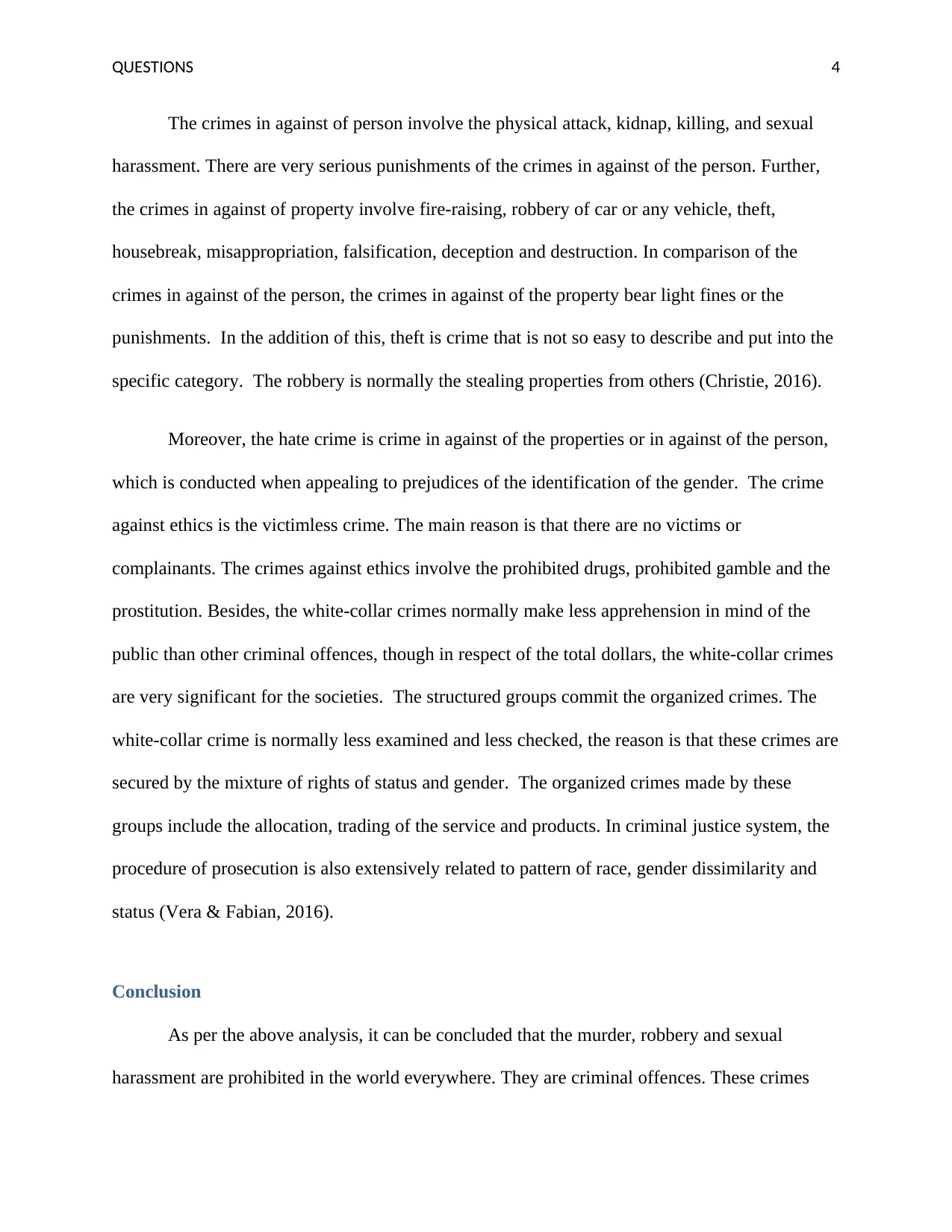
QUESTIONS 4
The crimes in against of person involve the physical attack, kidnap, killing, and sexual
harassment. There are very serious punishments of the crimes in against of the person. Further,
the crimes in against of property involve fire-raising, robbery of car or any vehicle, theft,
housebreak, misappropriation, falsification, deception and destruction. In comparison of the
crimes in against of the person, the crimes in against of the property bear light fines or the
punishments. In the addition of this, theft is crime that is not so easy to describe and put into the
specific category. The robbery is normally the stealing properties from others (Christie, 2016).
Moreover, the hate crime is crime in against of the properties or in against of the person,
which is conducted when appealing to prejudices of the identification of the gender. The crime
against ethics is the victimless crime. The main reason is that there are no victims or
complainants. The crimes against ethics involve the prohibited drugs, prohibited gamble and the
prostitution. Besides, the white-collar crimes normally make less apprehension in mind of the
public than other criminal offences, though in respect of the total dollars, the white-collar crimes
are very significant for the societies. The structured groups commit the organized crimes. The
white-collar crime is normally less examined and less checked, the reason is that these crimes are
secured by the mixture of rights of status and gender. The organized crimes made by these
groups include the allocation, trading of the service and products. In criminal justice system, the
procedure of prosecution is also extensively related to pattern of race, gender dissimilarity and
status (Vera & Fabian, 2016).
Conclusion
As per the above analysis, it can be concluded that the murder, robbery and sexual
harassment are prohibited in the world everywhere. They are criminal offences. These crimes
The crimes in against of person involve the physical attack, kidnap, killing, and sexual
harassment. There are very serious punishments of the crimes in against of the person. Further,
the crimes in against of property involve fire-raising, robbery of car or any vehicle, theft,
housebreak, misappropriation, falsification, deception and destruction. In comparison of the
crimes in against of the person, the crimes in against of the property bear light fines or the
punishments. In the addition of this, theft is crime that is not so easy to describe and put into the
specific category. The robbery is normally the stealing properties from others (Christie, 2016).
Moreover, the hate crime is crime in against of the properties or in against of the person,
which is conducted when appealing to prejudices of the identification of the gender. The crime
against ethics is the victimless crime. The main reason is that there are no victims or
complainants. The crimes against ethics involve the prohibited drugs, prohibited gamble and the
prostitution. Besides, the white-collar crimes normally make less apprehension in mind of the
public than other criminal offences, though in respect of the total dollars, the white-collar crimes
are very significant for the societies. The structured groups commit the organized crimes. The
white-collar crime is normally less examined and less checked, the reason is that these crimes are
secured by the mixture of rights of status and gender. The organized crimes made by these
groups include the allocation, trading of the service and products. In criminal justice system, the
procedure of prosecution is also extensively related to pattern of race, gender dissimilarity and
status (Vera & Fabian, 2016).
Conclusion
As per the above analysis, it can be concluded that the murder, robbery and sexual
harassment are prohibited in the world everywhere. They are criminal offences. These crimes
Paraphrase This Document
Need a fresh take? Get an instant paraphrase of this document with our AI Paraphraser
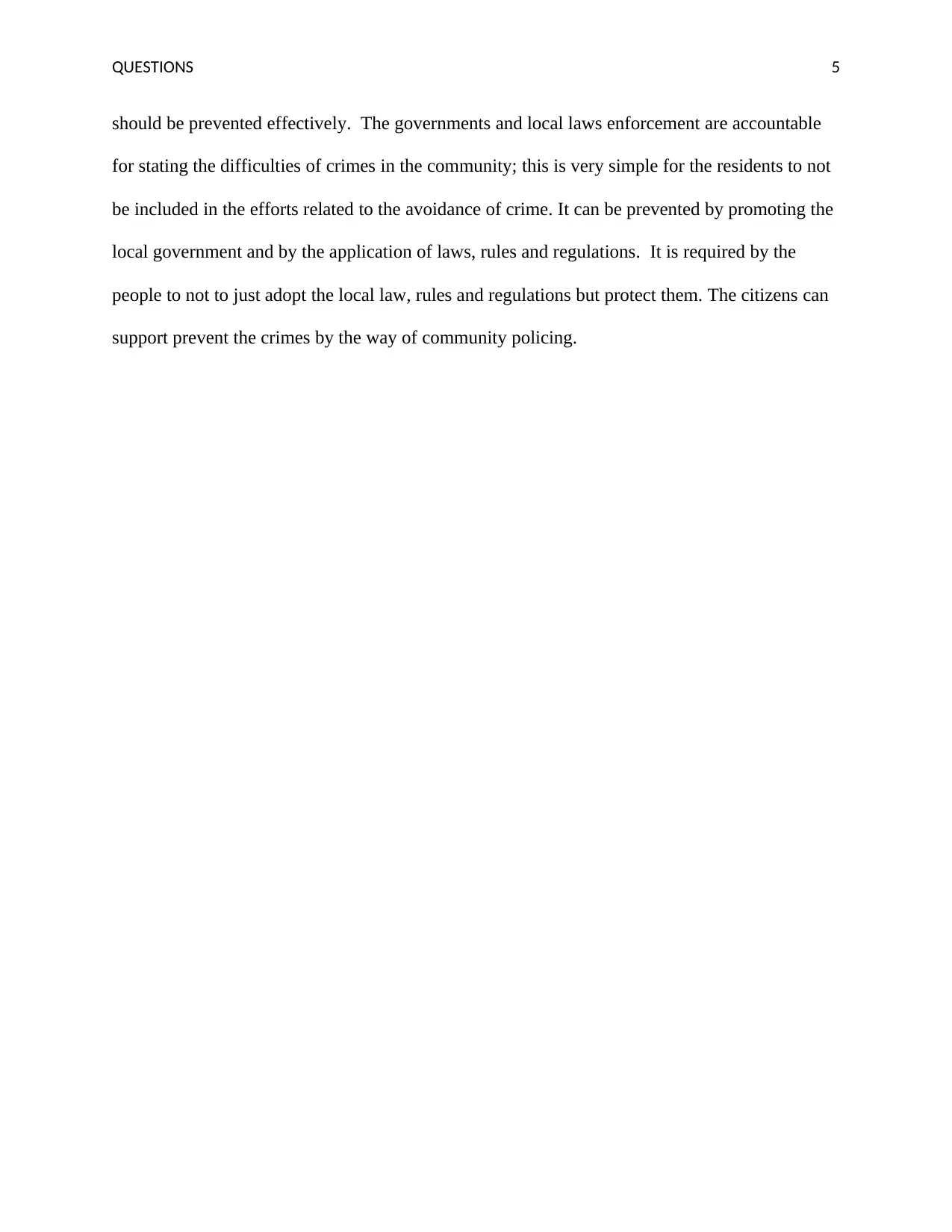
QUESTIONS 5
should be prevented effectively. The governments and local laws enforcement are accountable
for stating the difficulties of crimes in the community; this is very simple for the residents to not
be included in the efforts related to the avoidance of crime. It can be prevented by promoting the
local government and by the application of laws, rules and regulations. It is required by the
people to not to just adopt the local law, rules and regulations but protect them. The citizens can
support prevent the crimes by the way of community policing.
should be prevented effectively. The governments and local laws enforcement are accountable
for stating the difficulties of crimes in the community; this is very simple for the residents to not
be included in the efforts related to the avoidance of crime. It can be prevented by promoting the
local government and by the application of laws, rules and regulations. It is required by the
people to not to just adopt the local law, rules and regulations but protect them. The citizens can
support prevent the crimes by the way of community policing.
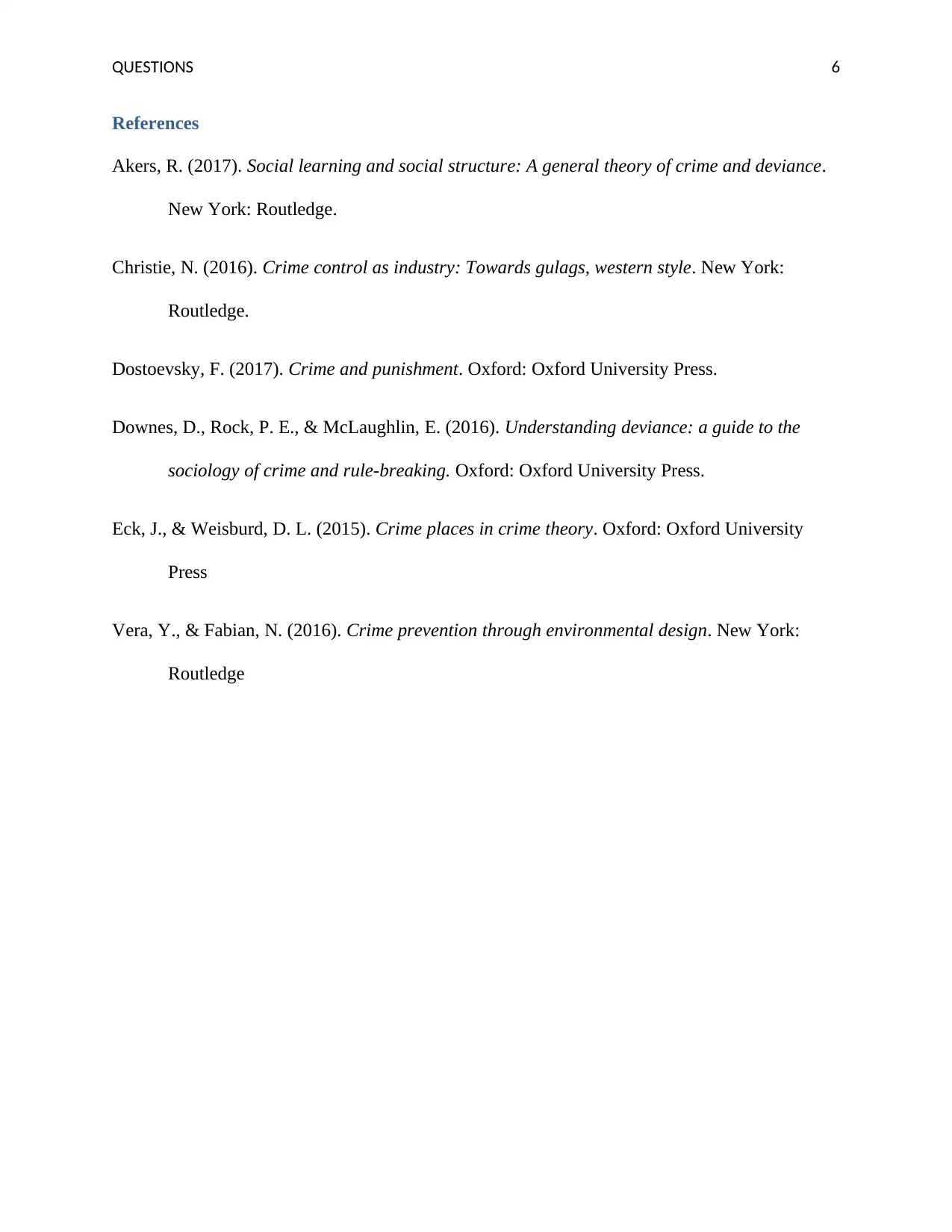
QUESTIONS 6
References
Akers, R. (2017). Social learning and social structure: A general theory of crime and deviance.
New York: Routledge.
Christie, N. (2016). Crime control as industry: Towards gulags, western style. New York:
Routledge.
Dostoevsky, F. (2017). Crime and punishment. Oxford: Oxford University Press.
Downes, D., Rock, P. E., & McLaughlin, E. (2016). Understanding deviance: a guide to the
sociology of crime and rule-breaking. Oxford: Oxford University Press.
Eck, J., & Weisburd, D. L. (2015). Crime places in crime theory. Oxford: Oxford University
Press
Vera, Y., & Fabian, N. (2016). Crime prevention through environmental design. New York:
Routledge
References
Akers, R. (2017). Social learning and social structure: A general theory of crime and deviance.
New York: Routledge.
Christie, N. (2016). Crime control as industry: Towards gulags, western style. New York:
Routledge.
Dostoevsky, F. (2017). Crime and punishment. Oxford: Oxford University Press.
Downes, D., Rock, P. E., & McLaughlin, E. (2016). Understanding deviance: a guide to the
sociology of crime and rule-breaking. Oxford: Oxford University Press.
Eck, J., & Weisburd, D. L. (2015). Crime places in crime theory. Oxford: Oxford University
Press
Vera, Y., & Fabian, N. (2016). Crime prevention through environmental design. New York:
Routledge
⊘ This is a preview!⊘
Do you want full access?
Subscribe today to unlock all pages.

Trusted by 1+ million students worldwide
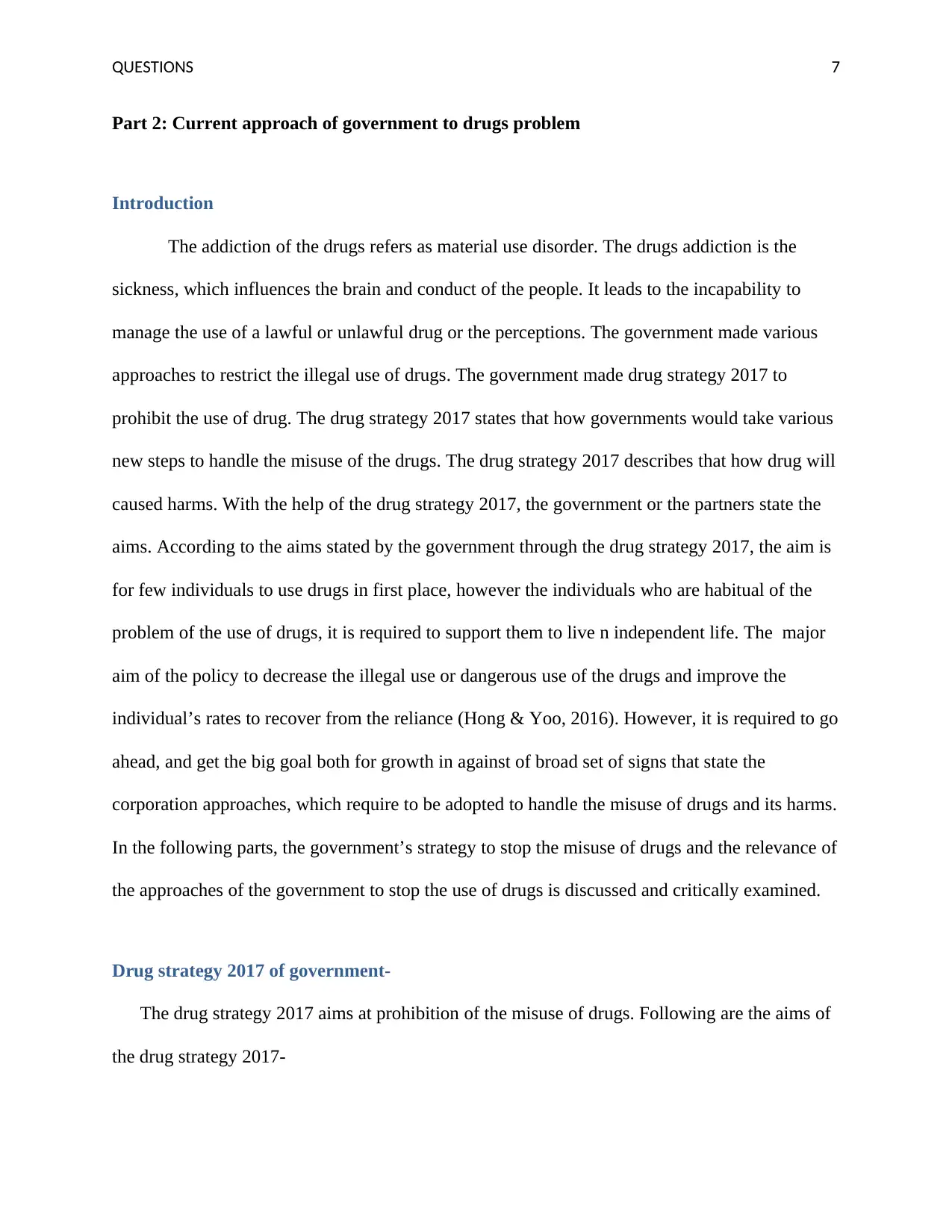
QUESTIONS 7
Part 2: Current approach of government to drugs problem
Introduction
The addiction of the drugs refers as material use disorder. The drugs addiction is the
sickness, which influences the brain and conduct of the people. It leads to the incapability to
manage the use of a lawful or unlawful drug or the perceptions. The government made various
approaches to restrict the illegal use of drugs. The government made drug strategy 2017 to
prohibit the use of drug. The drug strategy 2017 states that how governments would take various
new steps to handle the misuse of the drugs. The drug strategy 2017 describes that how drug will
caused harms. With the help of the drug strategy 2017, the government or the partners state the
aims. According to the aims stated by the government through the drug strategy 2017, the aim is
for few individuals to use drugs in first place, however the individuals who are habitual of the
problem of the use of drugs, it is required to support them to live n independent life. The major
aim of the policy to decrease the illegal use or dangerous use of the drugs and improve the
individual’s rates to recover from the reliance (Hong & Yoo, 2016). However, it is required to go
ahead, and get the big goal both for growth in against of broad set of signs that state the
corporation approaches, which require to be adopted to handle the misuse of drugs and its harms.
In the following parts, the government’s strategy to stop the misuse of drugs and the relevance of
the approaches of the government to stop the use of drugs is discussed and critically examined.
Drug strategy 2017 of government-
The drug strategy 2017 aims at prohibition of the misuse of drugs. Following are the aims of
the drug strategy 2017-
Part 2: Current approach of government to drugs problem
Introduction
The addiction of the drugs refers as material use disorder. The drugs addiction is the
sickness, which influences the brain and conduct of the people. It leads to the incapability to
manage the use of a lawful or unlawful drug or the perceptions. The government made various
approaches to restrict the illegal use of drugs. The government made drug strategy 2017 to
prohibit the use of drug. The drug strategy 2017 states that how governments would take various
new steps to handle the misuse of the drugs. The drug strategy 2017 describes that how drug will
caused harms. With the help of the drug strategy 2017, the government or the partners state the
aims. According to the aims stated by the government through the drug strategy 2017, the aim is
for few individuals to use drugs in first place, however the individuals who are habitual of the
problem of the use of drugs, it is required to support them to live n independent life. The major
aim of the policy to decrease the illegal use or dangerous use of the drugs and improve the
individual’s rates to recover from the reliance (Hong & Yoo, 2016). However, it is required to go
ahead, and get the big goal both for growth in against of broad set of signs that state the
corporation approaches, which require to be adopted to handle the misuse of drugs and its harms.
In the following parts, the government’s strategy to stop the misuse of drugs and the relevance of
the approaches of the government to stop the use of drugs is discussed and critically examined.
Drug strategy 2017 of government-
The drug strategy 2017 aims at prohibition of the misuse of drugs. Following are the aims of
the drug strategy 2017-
Paraphrase This Document
Need a fresh take? Get an instant paraphrase of this document with our AI Paraphraser
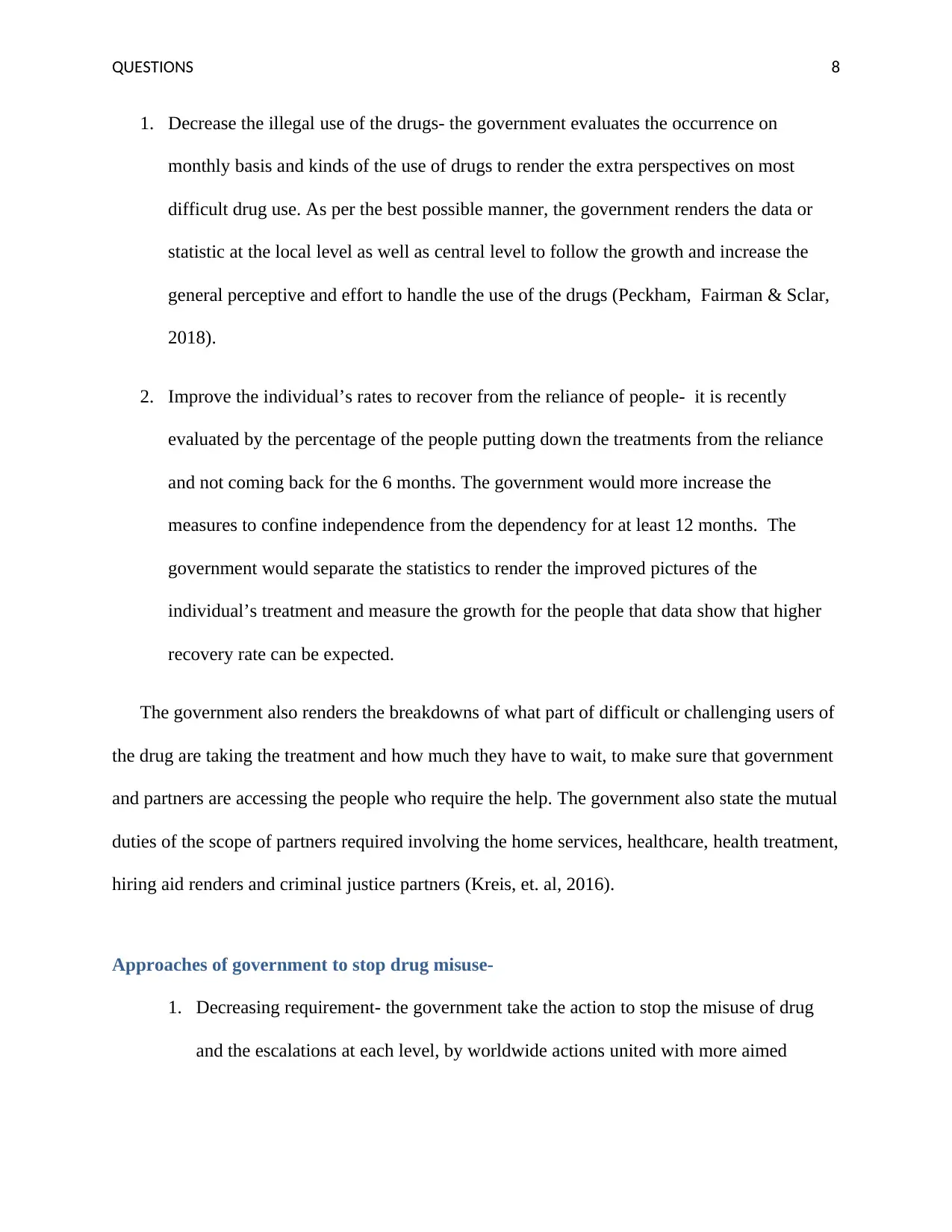
QUESTIONS 8
1. Decrease the illegal use of the drugs- the government evaluates the occurrence on
monthly basis and kinds of the use of drugs to render the extra perspectives on most
difficult drug use. As per the best possible manner, the government renders the data or
statistic at the local level as well as central level to follow the growth and increase the
general perceptive and effort to handle the use of the drugs (Peckham, Fairman & Sclar,
2018).
2. Improve the individual’s rates to recover from the reliance of people- it is recently
evaluated by the percentage of the people putting down the treatments from the reliance
and not coming back for the 6 months. The government would more increase the
measures to confine independence from the dependency for at least 12 months. The
government would separate the statistics to render the improved pictures of the
individual’s treatment and measure the growth for the people that data show that higher
recovery rate can be expected.
The government also renders the breakdowns of what part of difficult or challenging users of
the drug are taking the treatment and how much they have to wait, to make sure that government
and partners are accessing the people who require the help. The government also state the mutual
duties of the scope of partners required involving the home services, healthcare, health treatment,
hiring aid renders and criminal justice partners (Kreis, et. al, 2016).
Approaches of government to stop drug misuse-
1. Decreasing requirement- the government take the action to stop the misuse of drug
and the escalations at each level, by worldwide actions united with more aimed
1. Decrease the illegal use of the drugs- the government evaluates the occurrence on
monthly basis and kinds of the use of drugs to render the extra perspectives on most
difficult drug use. As per the best possible manner, the government renders the data or
statistic at the local level as well as central level to follow the growth and increase the
general perceptive and effort to handle the use of the drugs (Peckham, Fairman & Sclar,
2018).
2. Improve the individual’s rates to recover from the reliance of people- it is recently
evaluated by the percentage of the people putting down the treatments from the reliance
and not coming back for the 6 months. The government would more increase the
measures to confine independence from the dependency for at least 12 months. The
government would separate the statistics to render the improved pictures of the
individual’s treatment and measure the growth for the people that data show that higher
recovery rate can be expected.
The government also renders the breakdowns of what part of difficult or challenging users of
the drug are taking the treatment and how much they have to wait, to make sure that government
and partners are accessing the people who require the help. The government also state the mutual
duties of the scope of partners required involving the home services, healthcare, health treatment,
hiring aid renders and criminal justice partners (Kreis, et. al, 2016).
Approaches of government to stop drug misuse-
1. Decreasing requirement- the government take the action to stop the misuse of drug
and the escalations at each level, by worldwide actions united with more aimed
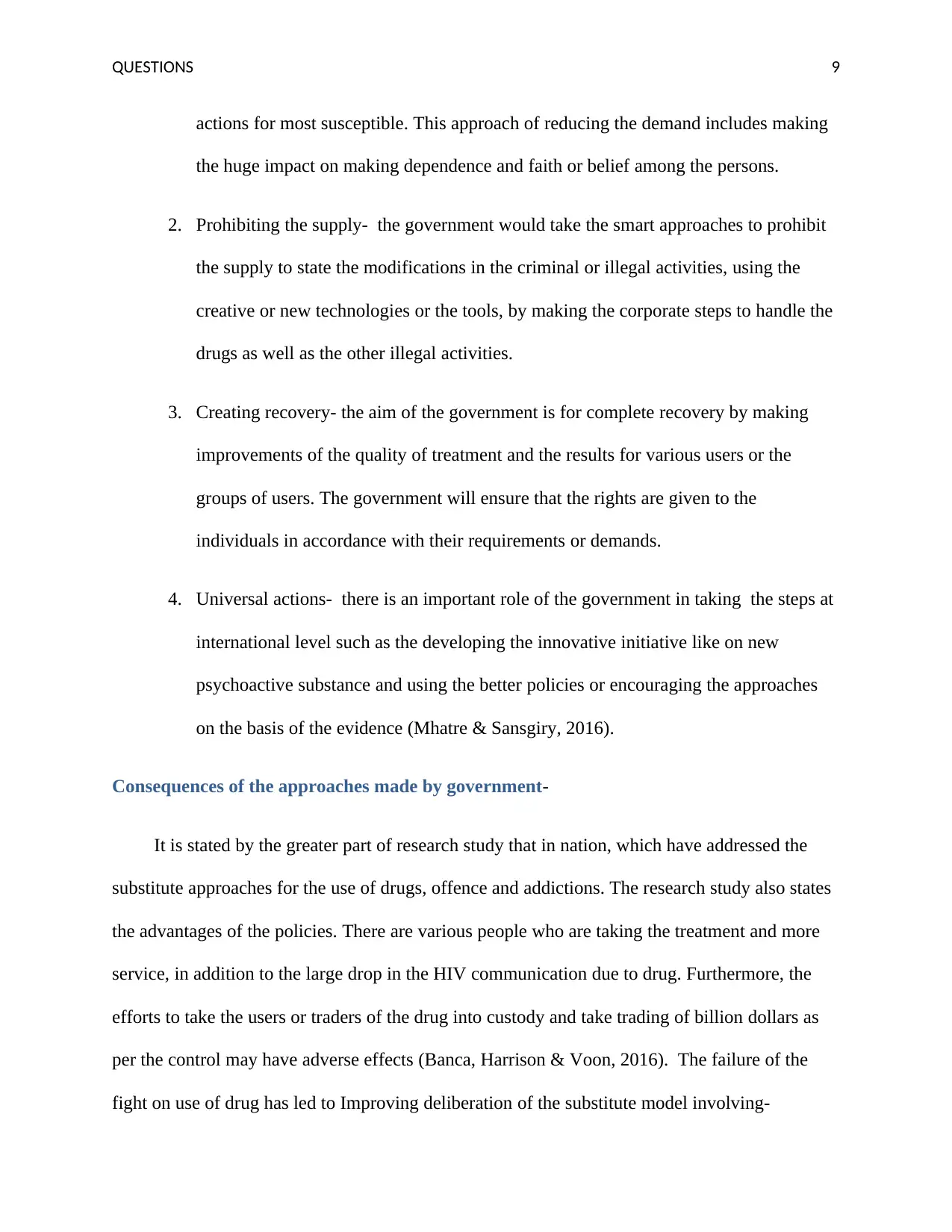
QUESTIONS 9
actions for most susceptible. This approach of reducing the demand includes making
the huge impact on making dependence and faith or belief among the persons.
2. Prohibiting the supply- the government would take the smart approaches to prohibit
the supply to state the modifications in the criminal or illegal activities, using the
creative or new technologies or the tools, by making the corporate steps to handle the
drugs as well as the other illegal activities.
3. Creating recovery- the aim of the government is for complete recovery by making
improvements of the quality of treatment and the results for various users or the
groups of users. The government will ensure that the rights are given to the
individuals in accordance with their requirements or demands.
4. Universal actions- there is an important role of the government in taking the steps at
international level such as the developing the innovative initiative like on new
psychoactive substance and using the better policies or encouraging the approaches
on the basis of the evidence (Mhatre & Sansgiry, 2016).
Consequences of the approaches made by government-
It is stated by the greater part of research study that in nation, which have addressed the
substitute approaches for the use of drugs, offence and addictions. The research study also states
the advantages of the policies. There are various people who are taking the treatment and more
service, in addition to the large drop in the HIV communication due to drug. Furthermore, the
efforts to take the users or traders of the drug into custody and take trading of billion dollars as
per the control may have adverse effects (Banca, Harrison & Voon, 2016). The failure of the
fight on use of drug has led to Improving deliberation of the substitute model involving-
actions for most susceptible. This approach of reducing the demand includes making
the huge impact on making dependence and faith or belief among the persons.
2. Prohibiting the supply- the government would take the smart approaches to prohibit
the supply to state the modifications in the criminal or illegal activities, using the
creative or new technologies or the tools, by making the corporate steps to handle the
drugs as well as the other illegal activities.
3. Creating recovery- the aim of the government is for complete recovery by making
improvements of the quality of treatment and the results for various users or the
groups of users. The government will ensure that the rights are given to the
individuals in accordance with their requirements or demands.
4. Universal actions- there is an important role of the government in taking the steps at
international level such as the developing the innovative initiative like on new
psychoactive substance and using the better policies or encouraging the approaches
on the basis of the evidence (Mhatre & Sansgiry, 2016).
Consequences of the approaches made by government-
It is stated by the greater part of research study that in nation, which have addressed the
substitute approaches for the use of drugs, offence and addictions. The research study also states
the advantages of the policies. There are various people who are taking the treatment and more
service, in addition to the large drop in the HIV communication due to drug. Furthermore, the
efforts to take the users or traders of the drug into custody and take trading of billion dollars as
per the control may have adverse effects (Banca, Harrison & Voon, 2016). The failure of the
fight on use of drug has led to Improving deliberation of the substitute model involving-
⊘ This is a preview!⊘
Do you want full access?
Subscribe today to unlock all pages.

Trusted by 1+ million students worldwide
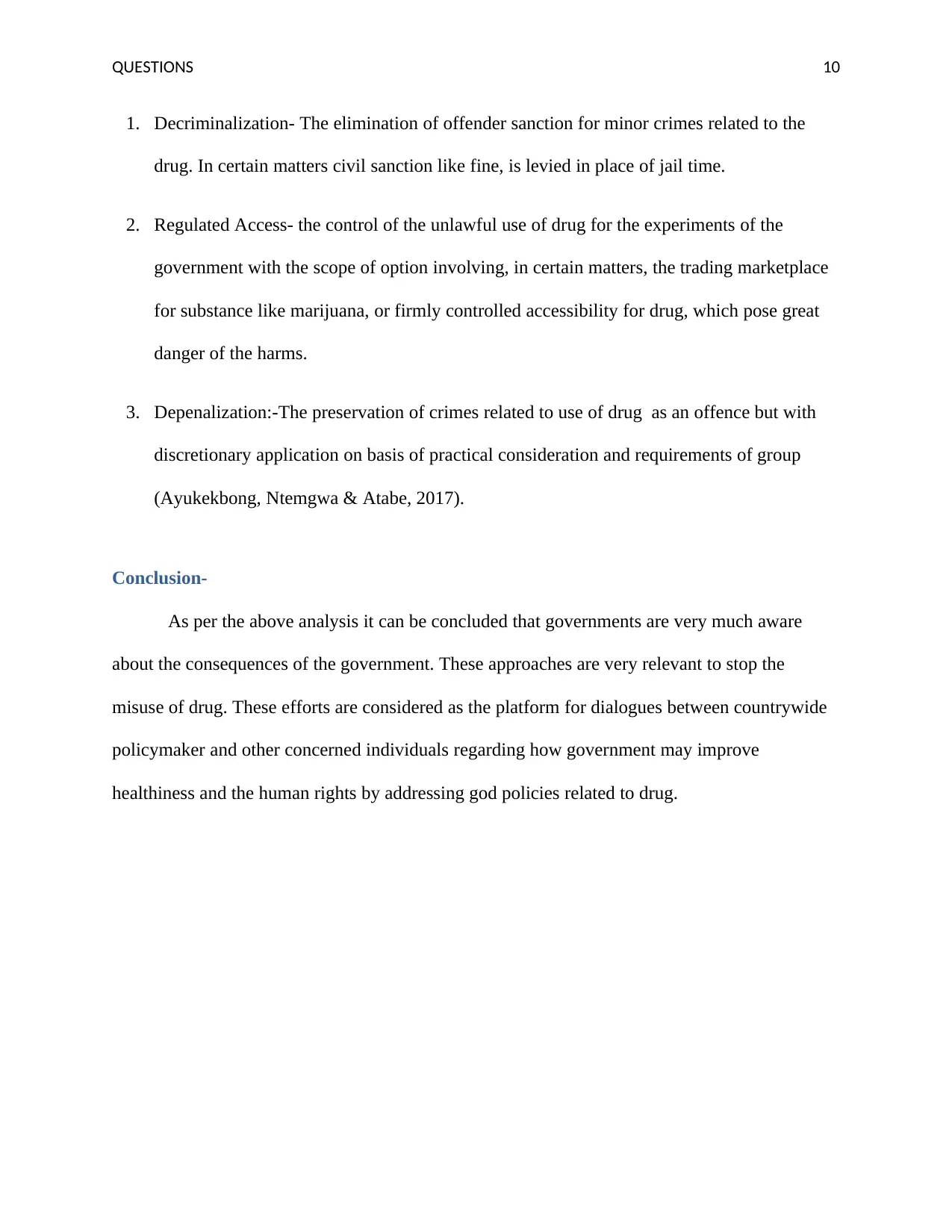
QUESTIONS 10
1. Decriminalization- The elimination of offender sanction for minor crimes related to the
drug. In certain matters civil sanction like fine, is levied in place of jail time.
2. Regulated Access- the control of the unlawful use of drug for the experiments of the
government with the scope of option involving, in certain matters, the trading marketplace
for substance like marijuana, or firmly controlled accessibility for drug, which pose great
danger of the harms.
3. Depenalization:-The preservation of crimes related to use of drug as an offence but with
discretionary application on basis of practical consideration and requirements of group
(Ayukekbong, Ntemgwa & Atabe, 2017).
Conclusion-
As per the above analysis it can be concluded that governments are very much aware
about the consequences of the government. These approaches are very relevant to stop the
misuse of drug. These efforts are considered as the platform for dialogues between countrywide
policymaker and other concerned individuals regarding how government may improve
healthiness and the human rights by addressing god policies related to drug.
1. Decriminalization- The elimination of offender sanction for minor crimes related to the
drug. In certain matters civil sanction like fine, is levied in place of jail time.
2. Regulated Access- the control of the unlawful use of drug for the experiments of the
government with the scope of option involving, in certain matters, the trading marketplace
for substance like marijuana, or firmly controlled accessibility for drug, which pose great
danger of the harms.
3. Depenalization:-The preservation of crimes related to use of drug as an offence but with
discretionary application on basis of practical consideration and requirements of group
(Ayukekbong, Ntemgwa & Atabe, 2017).
Conclusion-
As per the above analysis it can be concluded that governments are very much aware
about the consequences of the government. These approaches are very relevant to stop the
misuse of drug. These efforts are considered as the platform for dialogues between countrywide
policymaker and other concerned individuals regarding how government may improve
healthiness and the human rights by addressing god policies related to drug.
Paraphrase This Document
Need a fresh take? Get an instant paraphrase of this document with our AI Paraphraser
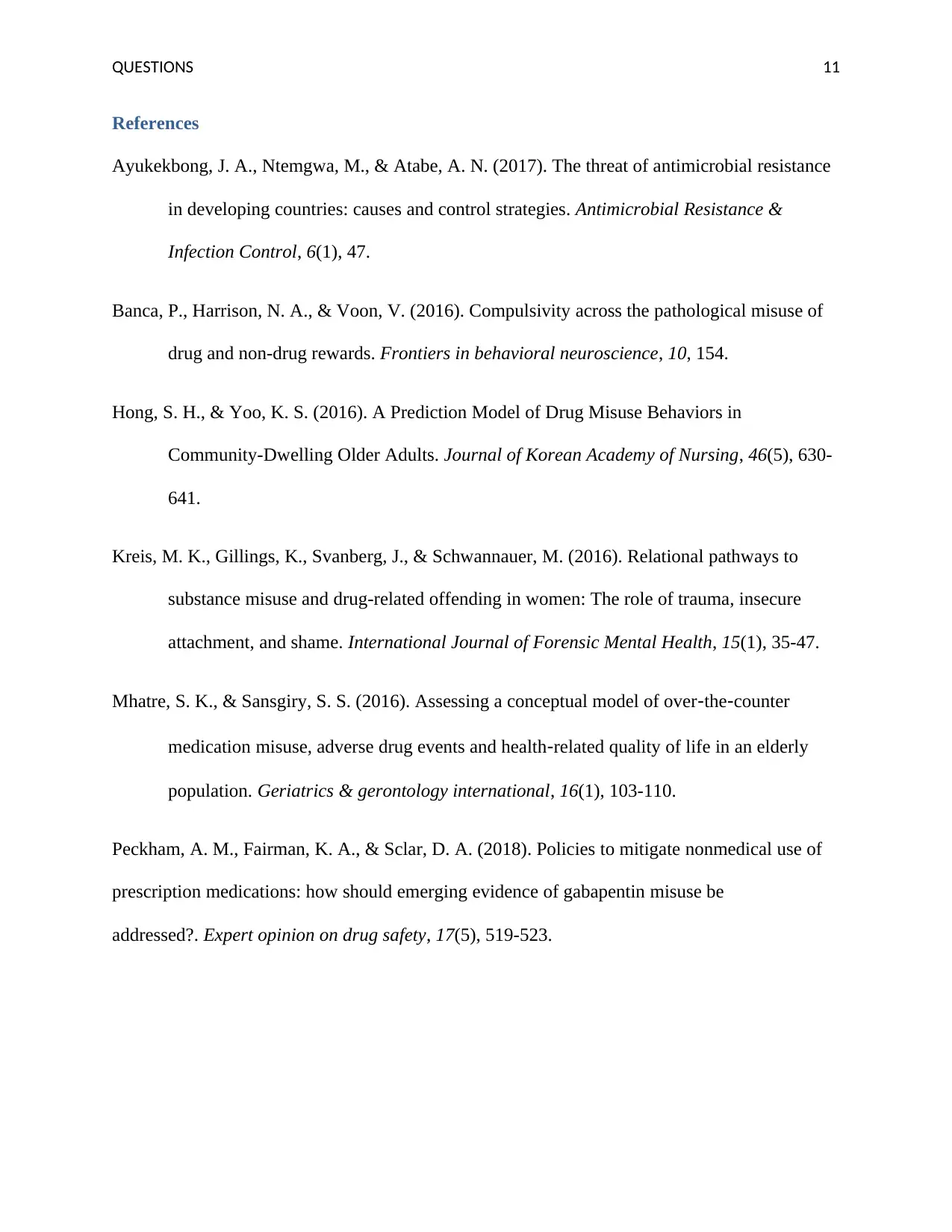
QUESTIONS 11
References
Ayukekbong, J. A., Ntemgwa, M., & Atabe, A. N. (2017). The threat of antimicrobial resistance
in developing countries: causes and control strategies. Antimicrobial Resistance &
Infection Control, 6(1), 47.
Banca, P., Harrison, N. A., & Voon, V. (2016). Compulsivity across the pathological misuse of
drug and non-drug rewards. Frontiers in behavioral neuroscience, 10, 154.
Hong, S. H., & Yoo, K. S. (2016). A Prediction Model of Drug Misuse Behaviors in
Community-Dwelling Older Adults. Journal of Korean Academy of Nursing, 46(5), 630-
641.
Kreis, M. K., Gillings, K., Svanberg, J., & Schwannauer, M. (2016). Relational pathways to
substance misuse and drug-related offending in women: The role of trauma, insecure
attachment, and shame. International Journal of Forensic Mental Health, 15(1), 35-47.
Mhatre, S. K., & Sansgiry, S. S. (2016). Assessing a conceptual model of over‐the‐counter
medication misuse, adverse drug events and health‐related quality of life in an elderly
population. Geriatrics & gerontology international, 16(1), 103-110.
Peckham, A. M., Fairman, K. A., & Sclar, D. A. (2018). Policies to mitigate nonmedical use of
prescription medications: how should emerging evidence of gabapentin misuse be
addressed?. Expert opinion on drug safety, 17(5), 519-523.
References
Ayukekbong, J. A., Ntemgwa, M., & Atabe, A. N. (2017). The threat of antimicrobial resistance
in developing countries: causes and control strategies. Antimicrobial Resistance &
Infection Control, 6(1), 47.
Banca, P., Harrison, N. A., & Voon, V. (2016). Compulsivity across the pathological misuse of
drug and non-drug rewards. Frontiers in behavioral neuroscience, 10, 154.
Hong, S. H., & Yoo, K. S. (2016). A Prediction Model of Drug Misuse Behaviors in
Community-Dwelling Older Adults. Journal of Korean Academy of Nursing, 46(5), 630-
641.
Kreis, M. K., Gillings, K., Svanberg, J., & Schwannauer, M. (2016). Relational pathways to
substance misuse and drug-related offending in women: The role of trauma, insecure
attachment, and shame. International Journal of Forensic Mental Health, 15(1), 35-47.
Mhatre, S. K., & Sansgiry, S. S. (2016). Assessing a conceptual model of over‐the‐counter
medication misuse, adverse drug events and health‐related quality of life in an elderly
population. Geriatrics & gerontology international, 16(1), 103-110.
Peckham, A. M., Fairman, K. A., & Sclar, D. A. (2018). Policies to mitigate nonmedical use of
prescription medications: how should emerging evidence of gabapentin misuse be
addressed?. Expert opinion on drug safety, 17(5), 519-523.
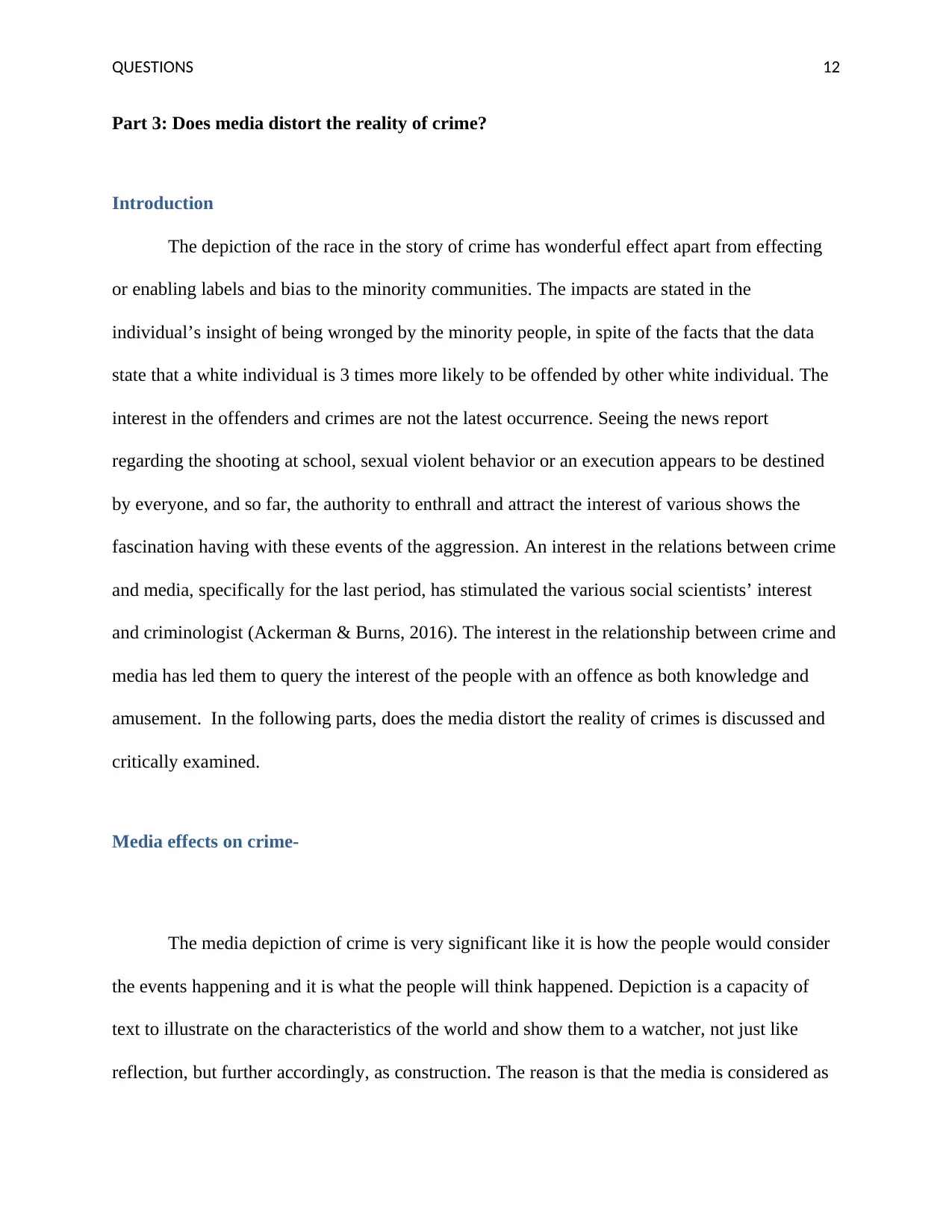
QUESTIONS 12
Part 3: Does media distort the reality of crime?
Introduction
The depiction of the race in the story of crime has wonderful effect apart from effecting
or enabling labels and bias to the minority communities. The impacts are stated in the
individual’s insight of being wronged by the minority people, in spite of the facts that the data
state that a white individual is 3 times more likely to be offended by other white individual. The
interest in the offenders and crimes are not the latest occurrence. Seeing the news report
regarding the shooting at school, sexual violent behavior or an execution appears to be destined
by everyone, and so far, the authority to enthrall and attract the interest of various shows the
fascination having with these events of the aggression. An interest in the relations between crime
and media, specifically for the last period, has stimulated the various social scientists’ interest
and criminologist (Ackerman & Burns, 2016). The interest in the relationship between crime and
media has led them to query the interest of the people with an offence as both knowledge and
amusement. In the following parts, does the media distort the reality of crimes is discussed and
critically examined.
Media effects on crime-
The media depiction of crime is very significant like it is how the people would consider
the events happening and it is what the people will think happened. Depiction is a capacity of
text to illustrate on the characteristics of the world and show them to a watcher, not just like
reflection, but further accordingly, as construction. The reason is that the media is considered as
Part 3: Does media distort the reality of crime?
Introduction
The depiction of the race in the story of crime has wonderful effect apart from effecting
or enabling labels and bias to the minority communities. The impacts are stated in the
individual’s insight of being wronged by the minority people, in spite of the facts that the data
state that a white individual is 3 times more likely to be offended by other white individual. The
interest in the offenders and crimes are not the latest occurrence. Seeing the news report
regarding the shooting at school, sexual violent behavior or an execution appears to be destined
by everyone, and so far, the authority to enthrall and attract the interest of various shows the
fascination having with these events of the aggression. An interest in the relations between crime
and media, specifically for the last period, has stimulated the various social scientists’ interest
and criminologist (Ackerman & Burns, 2016). The interest in the relationship between crime and
media has led them to query the interest of the people with an offence as both knowledge and
amusement. In the following parts, does the media distort the reality of crimes is discussed and
critically examined.
Media effects on crime-
The media depiction of crime is very significant like it is how the people would consider
the events happening and it is what the people will think happened. Depiction is a capacity of
text to illustrate on the characteristics of the world and show them to a watcher, not just like
reflection, but further accordingly, as construction. The reason is that the media is considered as
⊘ This is a preview!⊘
Do you want full access?
Subscribe today to unlock all pages.

Trusted by 1+ million students worldwide
1 out of 16
Related Documents
Your All-in-One AI-Powered Toolkit for Academic Success.
+13062052269
info@desklib.com
Available 24*7 on WhatsApp / Email
![[object Object]](/_next/static/media/star-bottom.7253800d.svg)
Unlock your academic potential
Copyright © 2020–2025 A2Z Services. All Rights Reserved. Developed and managed by ZUCOL.





